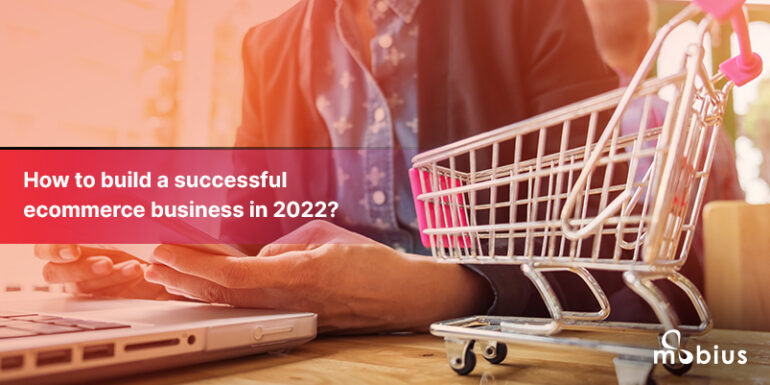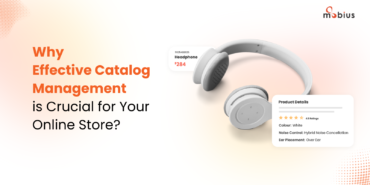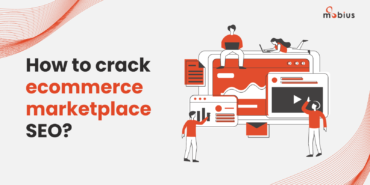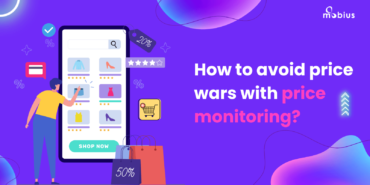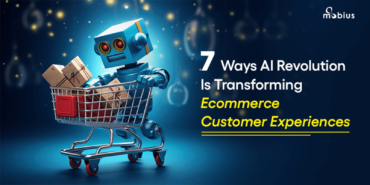The ecommerce industry is booming and is predicted to keep up its forward momentum and rapid growth. Online retailers, sellers, and entrepreneurs can make the most out of this opportunity to succeed. Needless to say, right now is the perfect time for online sellers to upgrade their existing ecommerce business or even start an ecommerce business venture. Either way, to have a successful ecommerce business, you need to tap into the world of AI-powered ecommerce solutions.
A recent study forecasted the global ecommerce industry to reach $55.6 Trillion by 2027 at a CAGR of 27.4% between 2022-2027. While the opportunity to grow your ecommerce business in this flourishing ecommerce economy is enormous, it is not one without challenges. And as every business is becoming increasingly reliant on data, the latest technologies, and expertise, the ecommerce industry is no exception.
Therefore, having the right ecommerce strategy and its timely execution will make a major difference in the growth and success rate of your business. Let’s understand the best practices for any ecommerce business and how different ecommerce solutions can ensure their implementation.
How can online sellers have a successful ecommerce business?
The pandemic has made the online selling game even more challenging due to many new online businesses entering the market worldwide. So, what can you do to ensure that you stand out from the crowd and have a profitable ecommerce business? We have put together a list of the most critical factors that can make or break a successful ecommerce business.
1. Having an omnichannel presence
Customers can buy your products only if they see your products online. To be visible to a broader audience, you need to ensure that your brand or products are present on as many platforms as possible. Research shows 95% of the purchases by 2040 will happen through ecommerce platforms. You can imagine how bigger this market is set to grow. Online sellers can increase ecommerce profitability and have their deserved market share through an omnichannel presence.
Sure, it is no joke taking your business to multiple online channels. And the bigger your product portfolio, the harder it becomes to manage product listings on different platforms. Product onboarding becomes a pain. It becomes impossible to update product information when required and follow different marketplace guidelines. Also, what happens when you decide to add a couple hundred more SKUs to your portfolio?
Well, there is good and bad news. The good news is you have many marketplace management services available in the market. The bad news is that it gets tricky when trying to pick the right one.
What to look for in a marketplace management solution?
Multi-channel onboarding is not an option. Retailers can effectively onboard their products onto any marketplace of their choice through accurate product categorization while making sure the product data format is channel compliant.
Listing optimization is yet another important aspect. Your product listings must be search engine friendly since each marketplace has its unique algorithm. This way, you can boost your product’s visibility on any platform you choose to sell.
Scalability is crucial. Retailers must choose a solution or a platform that offers scalability and allows you to seamlessly onboard bulk data onto multiple channels at a larger scale. Thus, ensuring product data accuracy and saving hours of manual efforts.
In addition, performance monitoring will enable insights such as your visitor traffic, engagement, product page ranking, and key performance. These analytics will help you understand overall product performance.
2. Displaying detailed and visually enticing product catalogs
Online shoppers cannot touch and feel the products like in the physical stores. The only access they have to know your product better is through the product page. Recent research shows that 88% of customers believe detailed product pages are crucial for making a purchasing decision.
In other words, customers make quicker and more confident decisions when they have all the product information they need to make the buying decision. But, displaying detailed, customer-centric, and visually enticing online catalogs manually is time-consuming and error-prone. Therefore, many online sellers and retailers often fail at effectively managing their catalogs and providing a good customer experience.
With catalog management, setting up an ecommerce business and upgrading your ecommerce store with rich product content has become as easy as taking a walk in the park. For instance, you can drive more conversions by optimizing product titles and descriptions, adding key features, images, videos, etc.
What to look for in a catalog management solution?
The right catalog management service or solution will give you access to ecommerce experts who collect and analyze product data from competitor and brand websites. They will capture relevant product information and provide you with complete data for your product catalogs.
Additionally, you can add more value and credibility to your products by adding quality product images and videos. You can even create unique links for your product images and give your customers a top purchasing experience.
3. Providing the best user experience
Your website or application’s performance, features, and security are equally important. It bothers customers when a website or product page takes too long to load or if they are unable to navigate easily on your website. A study shows that 38% of online shoppers will exit a website if it is unattractive.
However, creating a user-friendly website might be easier for sellers and retailers who are just joining the ecommerce space. What about the sellers who already have a website or application but still fail to attract enough customers? Website design and development services can help you drive conversions by providing the best UX experience to customers.
What to look for in an ecommerce design and development solution?
A good website design and development solution will help you add useful features like multiple payment options, links to your social media handles, and more. Moreover, you can even bring marketing features like discount coupons, gift cards, special offers, and more to make shopping with you exciting.
Online sellers can have an open-source website developed to support ecommerce websites like Shopify, Woocommerce, and Magento and seamlessly migrate the website to any ecommerce platform.
Brick and mortar sellers who are just setting up an ecommerce business can have a website designed that suits their brand and business goals. Having standard features, custom functionality, and user-friendly templates is crucial in increasing user engagement.
4. Taking customer service to the next level
The quality of your customer service can make or break your business. It’s that simple. Customers don’t care about the product quality or price if the customer experience is below satisfactory. They will switch to a different seller. 60% of customers say they stop buying from a brand if they have a negative customer experience.
So, what do your customers consider as a good customer service experience? A fast, positive response and issue resolution are enough to satisfy your customers. Remember, we live in an era where convenience is all everybody wants, and your customers want it instantly.
Of course, measuring up to customer expectations is challenging and gets more tricky when your customer base expands. It is impossible for online businesses to immediately scale up their customer service teams to match the increase in customers.
What to look for in an ecommerce help desk service?
To provide enhanced customer service, online sellers can leverage ecommerce customer service. Automation is the future, and you can start implementing it by powering your customer service with automated email, chat, and call support.
You can choose an ecommerce help desk service that provides round-the-clock support and acts as a cloud call center for your ecommerce business. Additionally, ensure the service offers multi-channel customer support to address customer queries at any touchpoint.
Chat support built on conversational AI can respond to standard customer queries with personalized responses. An automated chatbot can capture critical information from every customer message and connect the customer with the correct support agent based on the issue.
Responding to emails in real-time is possible with the right ecommerce solution. Online sellers can eliminate manually responding to large volumes of emails daily. You can automate personalized email responses and redirect complicated emails to support agents. Providing your customers with prompt customer service will do wonders for your business by establishing trust and loyalty.
Are you ready to grow your ecommerce business?
We live in a fast-changing world. If your online business is not moving fast enough, it will reach a stagnant stage. It is crucial to keep your customers at the forefront of every business decision and leverage the right business solutions, tools, or software to make your business profitable.
If you wonder how many different solutions you will need to drive your online business, you need not worry. We are a one-stop shop for all ecommerce solutions that your business will ever need. From building or optimizing your ecommerce website to managing your product catalog, monitoring your competitors, to managing your online reputation, we do it all.
Contact us to learn more about our ecommerce solutions and how we can help you with our two decades of experience in the ecommerce industry and technology.


